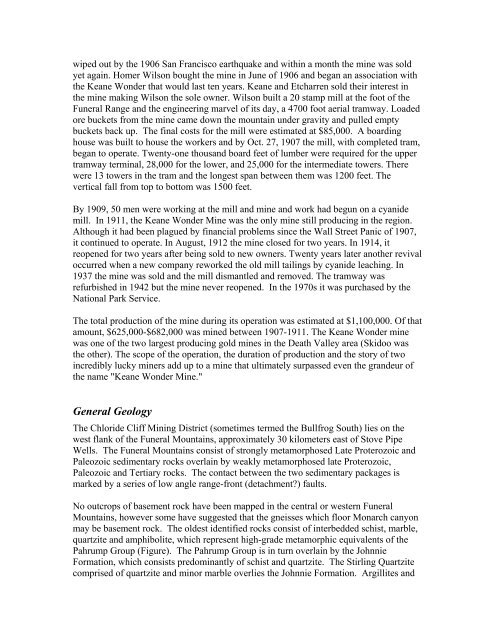Cal Poly Geology Club Death Valley Field Trip â 2004
Cal Poly Geology Club Death Valley Field Trip â 2004
Cal Poly Geology Club Death Valley Field Trip â 2004
Create successful ePaper yourself
Turn your PDF publications into a flip-book with our unique Google optimized e-Paper software.
wiped out by the 1906 San Francisco earthquake and within a month the mine was soldyet again. Homer Wilson bought the mine in June of 1906 and began an association withthe Keane Wonder that would last ten years. Keane and Etcharren sold their interest inthe mine making Wilson the sole owner. Wilson built a 20 stamp mill at the foot of theFuneral Range and the engineering marvel of its day, a 4700 foot aerial tramway. Loadedore buckets from the mine came down the mountain under gravity and pulled emptybuckets back up. The final costs for the mill were estimated at $85,000. A boardinghouse was built to house the workers and by Oct. 27, 1907 the mill, with completed tram,began to operate. Twenty-one thousand board feet of lumber were required for the uppertramway terminal, 28,000 for the lower, and 25,000 for the intermediate towers. Therewere 13 towers in the tram and the longest span between them was 1200 feet. Thevertical fall from top to bottom was 1500 feet.By 1909, 50 men were working at the mill and mine and work had begun on a cyanidemill. In 1911, the Keane Wonder Mine was the only mine still producing in the region.Although it had been plagued by financial problems since the Wall Street Panic of 1907,it continued to operate. In August, 1912 the mine closed for two years. In 1914, itreopened for two years after being sold to new owners. Twenty years later another revivaloccurred when a new company reworked the old mill tailings by cyanide leaching. In1937 the mine was sold and the mill dismantled and removed. The tramway wasrefurbished in 1942 but the mine never reopened. In the 1970s it was purchased by theNational Park Service.The total production of the mine during its operation was estimated at $1,100,000. Of thatamount, $625,000-$682,000 was mined between 1907-1911. The Keane Wonder minewas one of the two largest producing gold mines in the <strong>Death</strong> <strong>Valley</strong> area (Skidoo wasthe other). The scope of the operation, the duration of production and the story of twoincredibly lucky miners add up to a mine that ultimately surpassed even the grandeur ofthe name "Keane Wonder Mine."General <strong>Geology</strong>The Chloride Cliff Mining District (sometimes termed the Bullfrog South) lies on thewest flank of the Funeral Mountains, approximately 30 kilometers east of Stove PipeWells. The Funeral Mountains consist of strongly metamorphosed Late Proterozoic andPaleozoic sedimentary rocks overlain by weakly metamorphosed late Proterozoic,Paleozoic and Tertiary rocks. The contact between the two sedimentary packages ismarked by a series of low angle range-front (detachment?) faults.No outcrops of basement rock have been mapped in the central or western FuneralMountains, however some have suggested that the gneisses which floor Monarch canyonmay be basement rock. The oldest identified rocks consist of interbedded schist, marble,quartzite and amphibolite, which represent high-grade metamorphic equivalents of thePahrump Group (Figure). The Pahrump Group is in turn overlain by the JohnnieFormation, which consists predominantly of schist and quartzite. The Stirling Quartzitecomprised of quartzite and minor marble overlies the Johnnie Formation. Argillites and
















